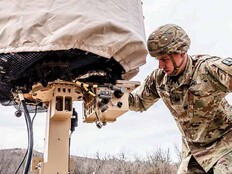Special Operations Command Sees Potential in AR, VR for Soldiers
For years, video game players have inhabited virtual combat worlds like those of the game “Halo,” in which the main character has an advanced combat display that aids in an interstellar fight. Now, the U.S. Special Operations Command wants to bring capabilities like that to the real world.
SOCOM announced last month that it was “interested in improvements and enhancements to visual augmentation systems (VAS) and related auxiliary technologies.” This also includes augmented reality and virtual reality solutions for “heads-up” displays, as well as the fusion of disparate data sources into a common visual display.
The special forces command hosted an “industry collaboration session” known formally as “Optical Dominance Industry Day” at Johns Hopkins University Applied Physics Laboratory on Nov. 14. The meeting was conducted in partnership with the Defense Department’s Rapid Reaction Technology Innovation Outreach Program, which “develops risk-reducing prototypes and demonstrations of land, sea, and air systems that address mission-focused combatant command, joint-Service, and interagency capability needs to counter emerging threats and provide a hedge against technical uncertainty.”
The outreach effort provides some insight into the kinds of capabilities SOCOM might possibly outfit special forces soldiers with in the future. It points to a future battlefield in which soldiers are fed information processed by artificial intelligence and their visual capabilities are enhanced by technologies like AR and VR.
MORE FROM FEDTECH: Find out how VR and AR can boost agency productivity!
How SOCOM Wants to Augment Soldiers’ Capabilities with Tech
SOCOM is looking for innovative technologies and capabilities in several different areas, including heads-up displays, AR/VR and AI/machine learning, displays with enhanced optical characteristics, multisensor data fusion and processing, communications and more.
Within these areas, SOCOM is interested in very specific technology applications. For example, under the AR/VR and AI/machine learning category, the command is interested in using such technologies for rehearsal and targeting before missions, holographic displays, gaming technologies, neuromorphic computing and engineering, telemedicine, and synthetic training and operational environments.
Under the heading of multisensor data fusion and processing, SOCOM would like to give soldiers the ability to use digital terrain elevation data (apriori), geo-rectified imagery, low-latency displays, 3D imagery in real time, GPS denied position navigation and timing, wireless data sharing (to eliminate cables), edge computing and on-board processing, analog to digital video conversion, and data compression algorithms.
According to a special notice released at the end of October, RRTO will partner with SOCOM to conduct a “solutions meeting” in the Laurel, Md., area in February 2019.
The solutions meeting “provides selected innovative companies with an opportunity to make short technical presentations to government representatives about their technologies and products.” SOCOM says there is “potential that companies may be selected for pilot projects or experimentation if their technology appears to match the needs” of the command.










